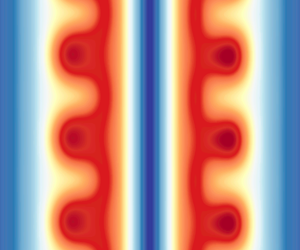Article contents
Nonlinear evolution of the centrifugal instability using a semilinear model
Published online by Cambridge University Press: 19 June 2020
Abstract

We study the nonlinear evolution of the axisymmetric centrifugal instability developing on a columnar anticyclone with a Gaussian angular velocity using a semilinear approach. The model consists of two coupled equations: one for the linear evolution of the most unstable perturbation on the axially averaged mean flow and another for the evolution of the mean flow under the effect of the axially averaged Reynolds stresses due to the perturbation. Such a model is similar to the self-consistent model of Mantič-Lugo et al. (Phys. Rev. Lett, vol. 113, 2014, 084501) except that the time averaging is replaced by a spatial averaging. The nonlinear evolutions of the mean flow and the perturbations predicted by this semilinear model are in very good agreement with direct numerical simulations for the Rossby number  $Ro=-4$ and both values of the Reynolds numbers investigated:
$Ro=-4$ and both values of the Reynolds numbers investigated:  $Re=800$ and
$Re=800$ and  $2000$ (based on the initial maximum angular velocity and radius of the vortex). An improved model, taking into account the second-harmonic perturbations, is also considered. The results show that the angular momentum of the mean flow is homogenized towards a centrifugally stable profile via the action of the Reynolds stresses of the fluctuations. The final velocity profile predicted by Kloosterziel et al. (J. Fluid Mech., vol. 583, 2007, pp. 379–412) in the inviscid limit is extended to finite high Reynolds numbers. It is in good agreement with the numerical simulations.
$2000$ (based on the initial maximum angular velocity and radius of the vortex). An improved model, taking into account the second-harmonic perturbations, is also considered. The results show that the angular momentum of the mean flow is homogenized towards a centrifugally stable profile via the action of the Reynolds stresses of the fluctuations. The final velocity profile predicted by Kloosterziel et al. (J. Fluid Mech., vol. 583, 2007, pp. 379–412) in the inviscid limit is extended to finite high Reynolds numbers. It is in good agreement with the numerical simulations.
Information
- Type
- JFM Papers
- Information
- Copyright
- © The Author(s), 2020. Published by Cambridge University Press
References
- 6
- Cited by

